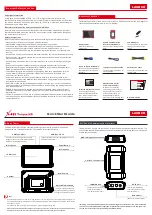
Section 2: Operating Procedures
SGC1060 & SGC1072 Grapples 380-092M
5/18/21
13
6. Operate hydraulic controls to verify control lever
movements function properly and equipment
movements are correct. Make any necessary
changes to controls and hydraulic hook-ups before
putting equipment into service.
7.
Operate grapple through its full range of movements
to check for clearances. Refer to
on page 12 for detailed instructions.
8. Purge hydraulic system of trapped air by operating all
hydraulic functions several times before putting unit
on page 12 in this manual and your tractor Operator’s
Manual if any hydraulic function continues to operate
erratic.
Operating Safety
DANGER
!
To avoid serious injury or death:
•
Keep attachment, loader arms, and/or load away from
overhead electrical power lines. Place an orange warning
sign under overhead lines indicating type of danger above.
•
Make sure the machine is stopped on solid, level ground
before raising load to dump. To maintain stability, raise
load only to the height necessary to complete the dump.
•
Never dump a load around gas lines, overhead power lines,
utilities, or other hazards that can cause serious injury or
death from electrocution, explosion, or fire.
•
Always secure equipment with solid, non-concrete supports
before working under it. Never go under equipment
supported by concrete blocks or hydraulics. Concrete can
break, hydraulic lines can burst, and/or hydraulic controls
can be actuated even when power to hydraulics is off.
•
Keep load positioned forward enough to prevent accidental
spillage on operator and power machine.
•
Keep load slightly tilted back to secure its weight against
the vertical face of the forks. Rotating front of forks too high
can cause the load to shift and fall onto the operator or
others. Rotating front of forks level or lower can cause the
•
Make sure all objects are contained and/or secured before
lifting. Do not lift a load that cannot be contained in the
attachment as the load can shift and fall.
•
Use a “spotter” when it is hard to see in the direction you
are traveling and when placing a load that obstructs your
vision. A person or animal could be nearby in a blind spot.
•
A crushing hazard always exists around attachments. The
jaws can crush and objects in the attachment can shift and
•
Do not drive up to anyone or an animal in front of a fixed
object such as a wall or bench. Never assume that the power
•
Do not lift a load that cannot be contained in the
attachment, exceeds the attachment’s load guard height, or
has objects smaller than the openings in the load guard.
Section 2: Operating Procedures
Operating Checklist
Hazard control and accident prevention are dependent
upon the awareness, concern, prudence and proper
training involved in the operation, transport, storage, and
maintenance of the Claw Grapple. Therefore, it is
absolutely essential that no one operates the unit unless
they have read, fully understood, and are totally familiar
with the Operator’s Manual. Make sure the operator has
completed the Operating Checklist below.
General Inspection
Make the following inspections with grapple attached to a
tractor that is parked on a level surface.
1. Complete Operating Checklist provided above.
2. Inspect tractor safety equipment to make sure it is in
good working condition and that all safety alert
decals are visible and legible. Replace all missing
and illegible safety alert decals.
3. Inspect hitch hook-up to grapple. Make sure front
mounted loader hitch is secured to the grapple as
follows:
Universal Quick Hitch:
Top of quick hitch is
secured under grapple’s top angle bars, lock pins
extend fully through bottom slots in grapple hitch,
and handles are locked down.
Kubota B Series Hitch:
Upper J-hooks are secured
under the grapple’s upper hitch pins, Kubota’s lower
hitch pins are properly installed, and wire retaining
pins are properly secured.
4. Consult your tractor Operator’s Manual to determine
if ballast is required. Add ballast if needed.
5. Inspect condition of hydraulic hoses, fittings, and
valves before starting the machine. Make sure hoses
are not pinched, kinked, twisted, or frayed and that
they will not contact moving parts.
Operating Checklist
Check
Page
Read and follow all safety rules carefully.
Refer to “Important Safety Information” and
Safety Alert Symbols throughout this manual.
All
Read and follow hook-up & preparation.
Refer to “Section 1: Assembly & Set-Up”.
Read and follow all operating procedures.
Refer to “Section 2: Operating Procedures”.
Read and follow all maintenance instructions.
Refer to “Section 3: Maintenance &
Make sure there are no hydraulic leaks.
Refer to “Avoid High Pressure Fluids Hazard”.
3
Check grapple initially and periodically for
loose bolts and pins.
Refer to “Torque Values Chart”.












































